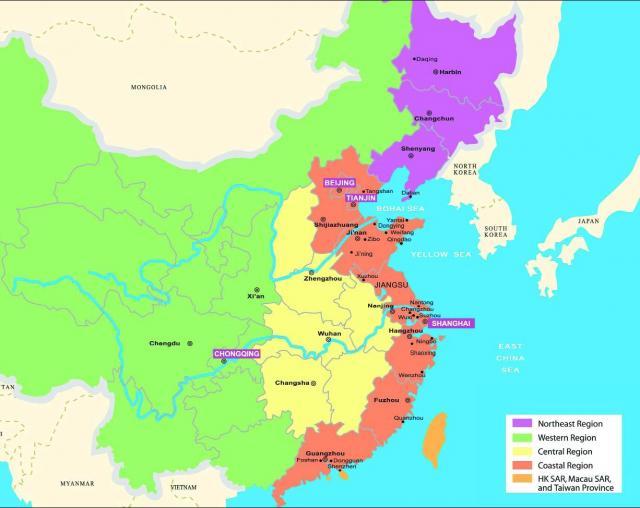Inside Out: China is Big, China is Small
J@pan Inc’s column concerning investment outside of Japan takes a look at China’s city ranking.
By Tiger Tong
 Source: China Knowledge
Source: China Knowledge
Rising costs and intensified competition in Beijing, Shanghai and other coastal cities have caused many investors to shift their attention to other parts of China. Though China is big, savvy investors who scrutinize the map of China might find their options limited as they plan their next step.
Acting as a measurement of economic size and prosperity, the ranking of China cities’ GDP (Gross Domestic Product) could provide some quick answers. In 2006, the top 40 Chinese cities with the highest GDP had a combined GDP of RMB11.34 trillion, comprising about 54% of the national figure. Taking into account ‘inflation’ added by the local government, we estimate the top 40 cities to form 43% of China’s total GDP. Bear in mind, the combined land area of these top 40 cities is only 5.5% of China’s total land area.
Not surprisingly, out of the top 40 cities, 29 are located in China’s coastal region. Given the fact that not every non-coastal city is ready for an influx of foreign investment, investors might for a start concentrate on the remaining 11 cities on the top 40 list. Among these, five are from northeastern China, the cradle of China’s industrialization.
After the recession in the late 1990s, the rejuvenation campaign, which started in 2003, has made the northeastern region rebound sharply. Yet, the northeastern region is not suitable for every investor. With the relationship between enterprises and the Chinese government remaining relatively complex, the old ‘planned economy mentality’ will still need a bit more time to diminish (Dalian, however, might be a exception).
SMEs might find another six cities in the hinterland easier to penetrate. Among them, Chongqing, the fourth municipality, Chengdu, Sichuan’s capital and Wuhan, Hubei’s capital, rank among the top 20 league. Indeed, these three cities should be in China’s top 10, in terms of human capital, as measured by the number of universities, college students and researchers.
Another noteworthy point is that Chengdu and Chongqing are often perceived to be arch-rivals despite belonging to the same province. However, a closer look reveals that both economies are actually complementary, rather than competitive.
While Chengdu is more focused on Hitech manufacturing, R&D and business processing outsourcing (BPO), Chongqing’s strength is in heavy industries, such as automobile and metallurgy. Mutual cooperation to gain a win-win situation would be another boost for both cities. Currently, the lack of partnership between cities has been one of the major drawbacks in the noncoastal regions of China.
The remaining three hinterland cities on top of the list are Zhengzhou, capital of Henan, the most populous province in China, Changsha, the capital of Hunan, and Xi’an, the capital of Shaanxi.
Of these three, Xi’an, with its wealth of human resources and status as a popular tourism destination, should have fared better. In 2006, however, its GDP ranked only 39th in China, compared with its top 10 ranking in the early 1980s. Relatively remote, Xi’an’s deteriorating environment might have contributed to its drop in ranking. Still, the government should take seriously, reasons for the drop in Xi’an’s GDP. Nevertheless, its rich human resource should be highly attractive to investors.
There are still two to three years left for potential investors to gain an early advantage in these lesser-known but relatively advanced non-coastal regions. Although all Chinese cities claim to be the best place for investment, potential investors might have varied preferences. The most important thing is to feel welcomed as an investor in the city, as business is ultimately about people.
Tiger Tong is an analyst with China Knowledge, a premier provider of trade and investment information on China.





